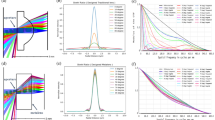Abstract
A gradient-index (GRIN) array is used as an imaging unit in light-emitting diode (LED) printers. In this study, we measure tilts of GRINs in an array and analyze the intensity distribution of the image to clarify the tilting amount and to evaluate the relation between the GRIN tilt and the degradation of the image. The arrangement intervals of the GRINs are measured, and the GRIN tilts are calculated from the differences between the arrangement intervals of the surfaces on one side and the other side. In our previous study, we show from ray matrix analysis that the images obtained using accurately arranged GRINs are superposed on a single image. However, images obtained using tilted GRINs are not superposed on a single image resulting in the image degradation. Measuring the tilt of the GRIN in the array is useful for improving the image. The upper limit on the tilt of the GRINs in the array for the LED printer is evaluated from a symmetric property of the image.











Similar content being viewed by others
References
Yamamura, A., Oka, K., Nishiguchi, N.: Alignment accuracy of gradient-index rod lens in an array. Opt. Eng. (2019). https://doi.org/10.1117/1.OE.58.8.085102
Yamamura, A.: Exposure unit, image forming unit, and image forming apparatus. U. S. Pat. 10001720 (2018)
Takagi, T., Hashimoto, H.: Method and apparatus for evaluating lens array arrangement. Jap. Laid-Open Pat. 2007–101416 (2007)
Yu, X., Liu, C., Zhang, Y., Xu, H., Wang, Y., Yu, W.: Multispectral curved compound eye camera. Opt. Express 28, 9216–9231 (2020). https://doi.org/10.1364/OE.20.385368
Grunwald, R., Huferath, S., Bock, M., Neumann, U., Langer, S.: Angular tolerance of Shack-Hartmann wavefront sensors with microaxicons. Opt. Lett. 32, 1533 (2007). https://doi.org/10.1364/OE.11.000927
Choi, H., Min, S., Jung, S., Park, J., Lee, B.: Multiple-viewing-zone integral imaging using a dynamic barrier array for three-dimensional displays. Opt. Express 11, 927–932 (2003). https://doi.org/10.1364/OE.11.000927
Nakamura, T., Horisaki, R., Tanida, J.: Computational superposition compound eye imaging for extended depth-of-field and field-of-view. Opt. Express 20, 27482–27495 (2012). https://doi.org/10.1109/JDT.2012.2202090
Shin, D., Javidi, B.: Resolution analysis of N-ocular imaging systems with tilted image sensors. J. Disp. Technol. 8, 529–533 (2012). https://doi.org/10.1109/JDT.2012.2202090
Acknowledgements
The authors would like to acknowledge the continuing guidance of Dr. Naoshi Baba, professor emeritus at Hokkaido University. They would also like to acknowledge the appreciative understanding and support of Mr. Tatsumi Yamaguchi and Mr. Kenichi Machiyama in Engineering Development Division of OKI DATA Corp.
Author information
Authors and Affiliations
Corresponding author
Rights and permissions
About this article
Cite this article
Yamamura, A., Oka, K. & Nishiguchi, N. Evaluation of gradient-index array alignment. Opt Rev 28, 64–72 (2021). https://doi.org/10.1007/s10043-020-00635-3
Received:
Accepted:
Published:
Issue Date:
DOI: https://doi.org/10.1007/s10043-020-00635-3




